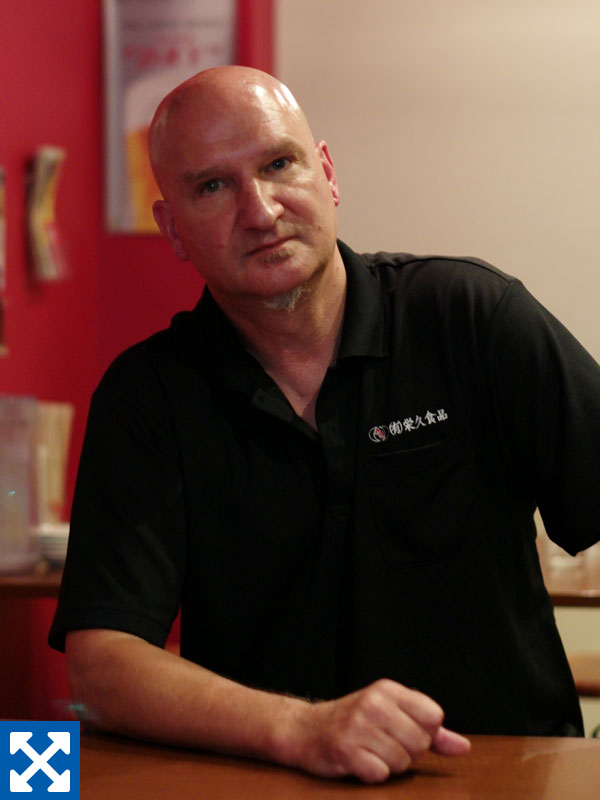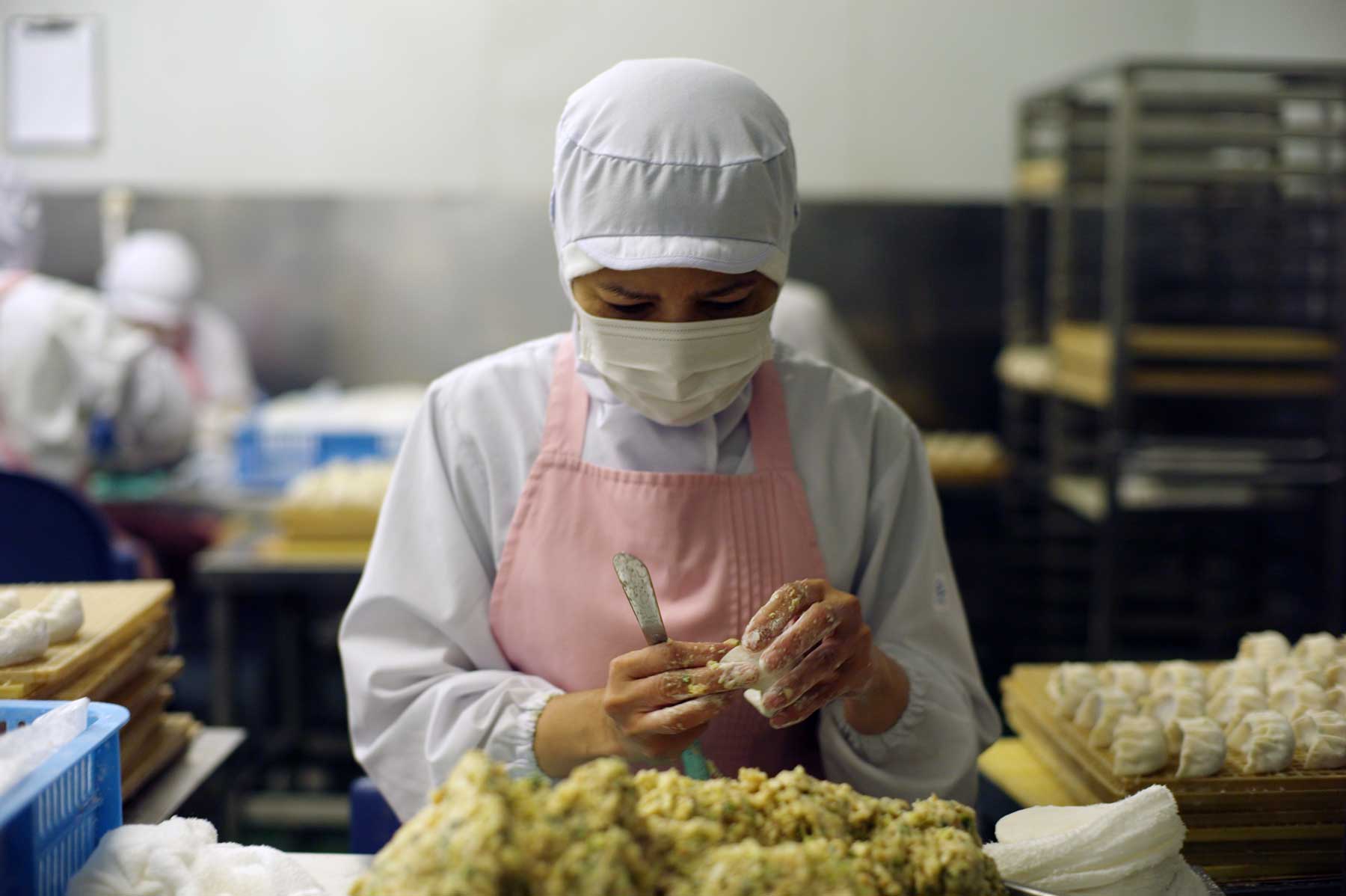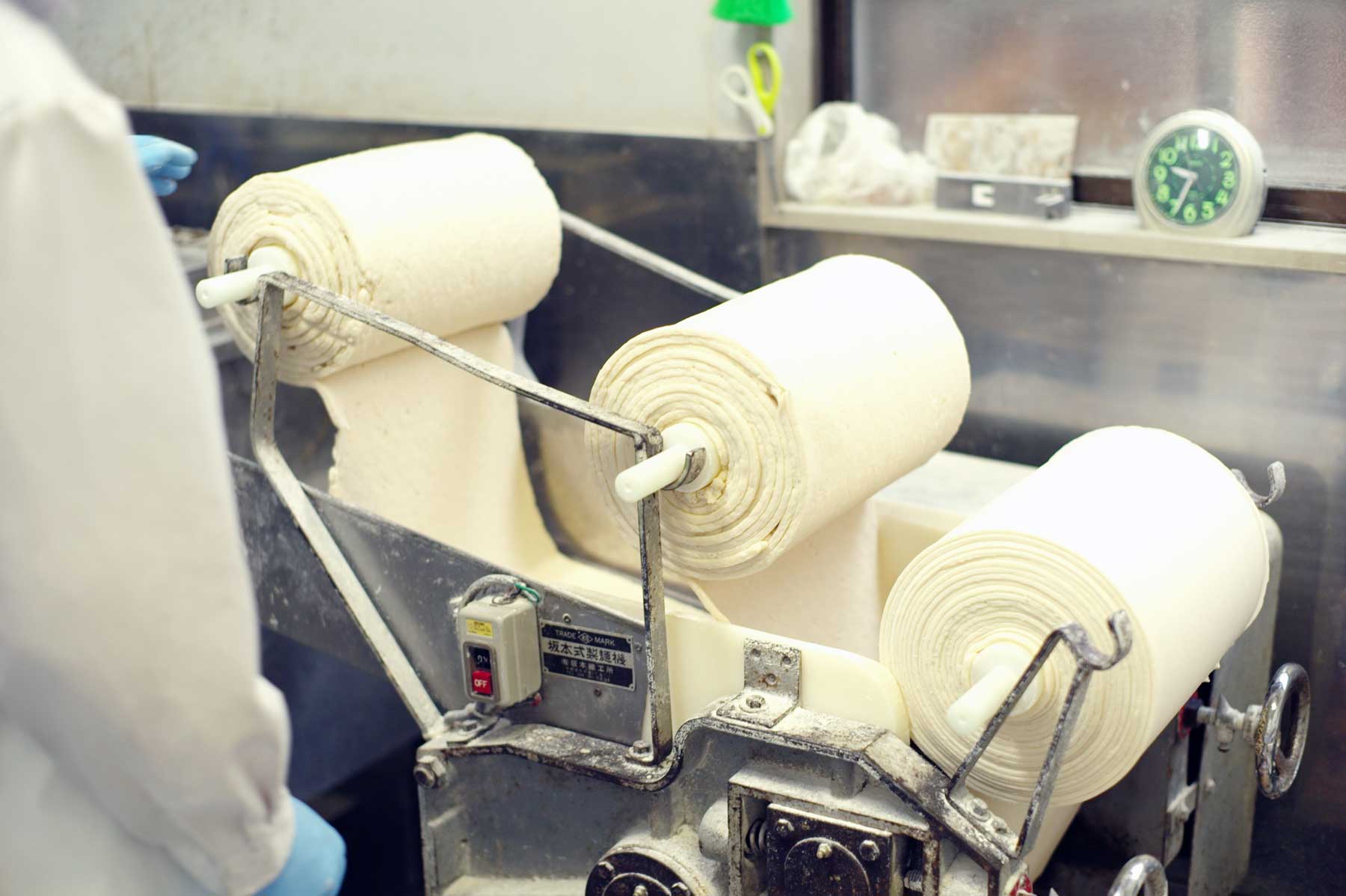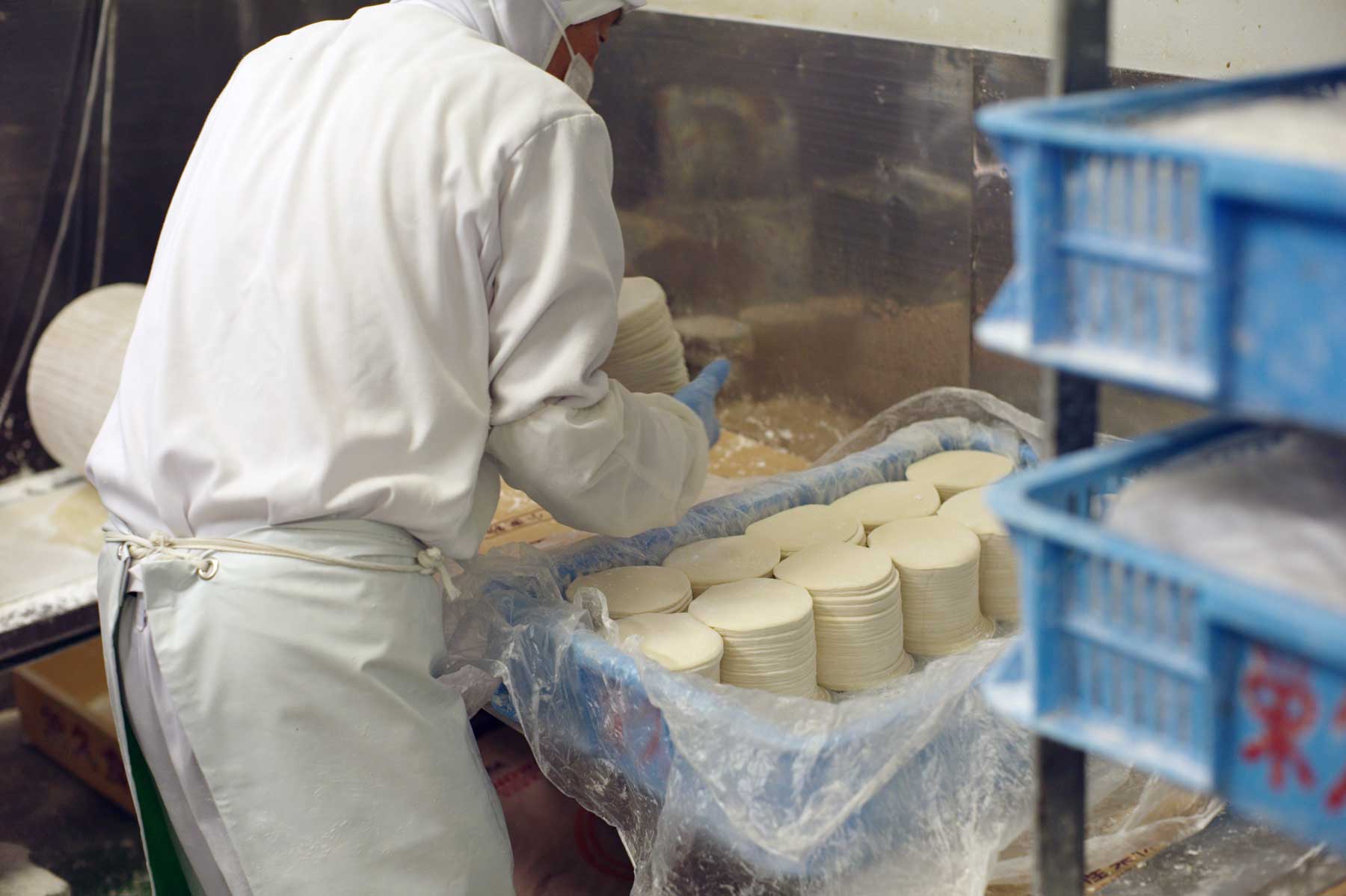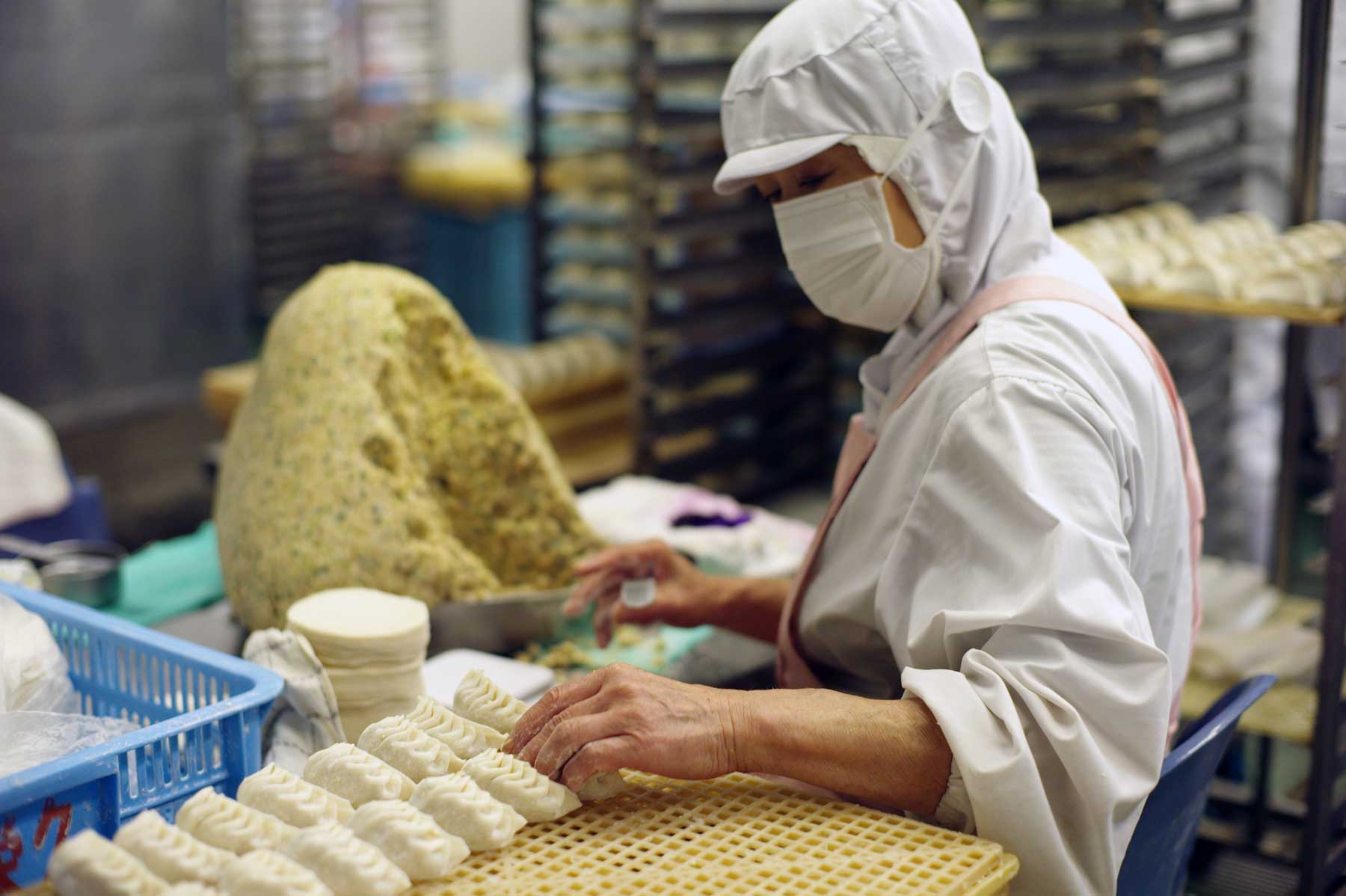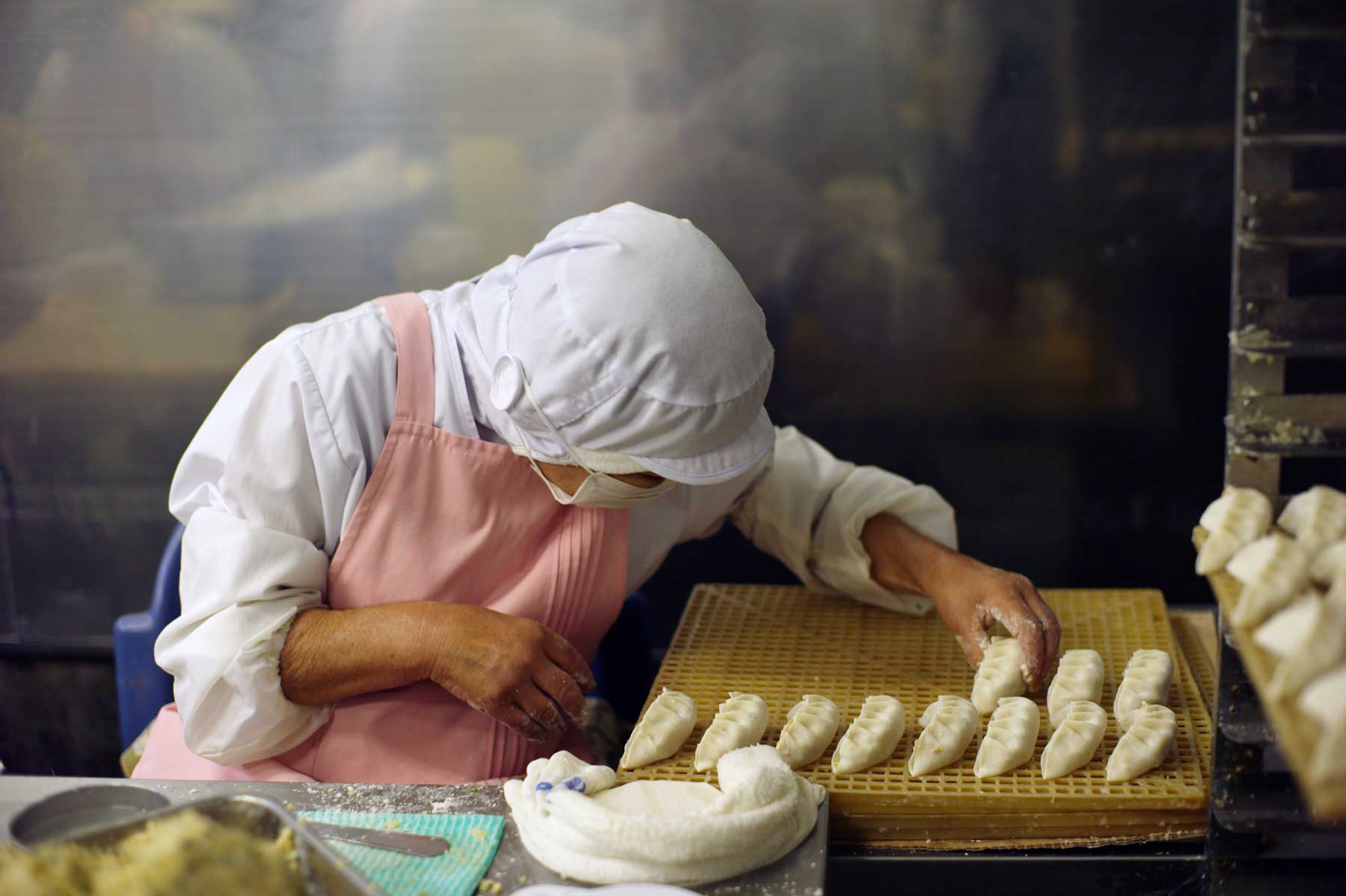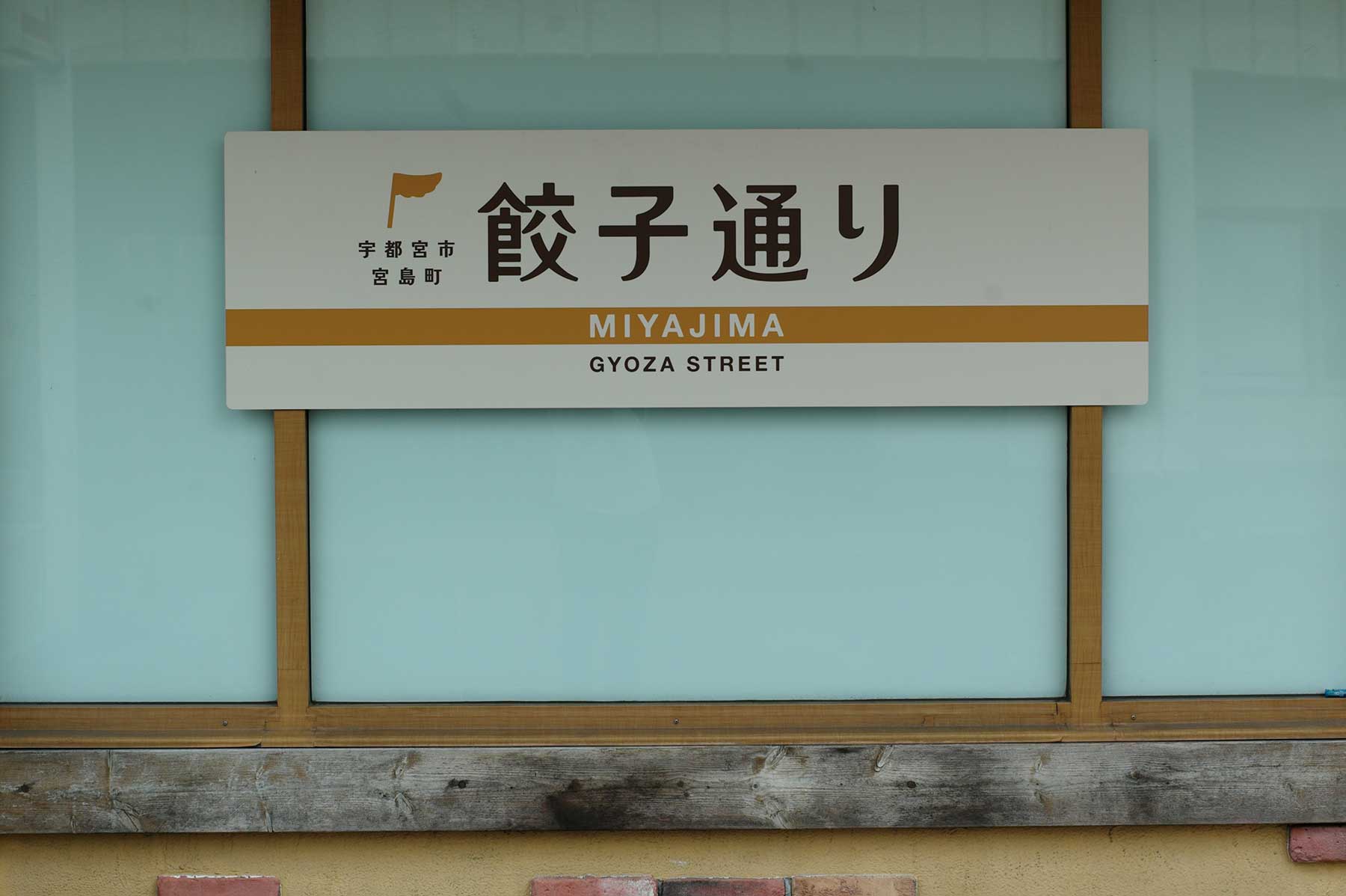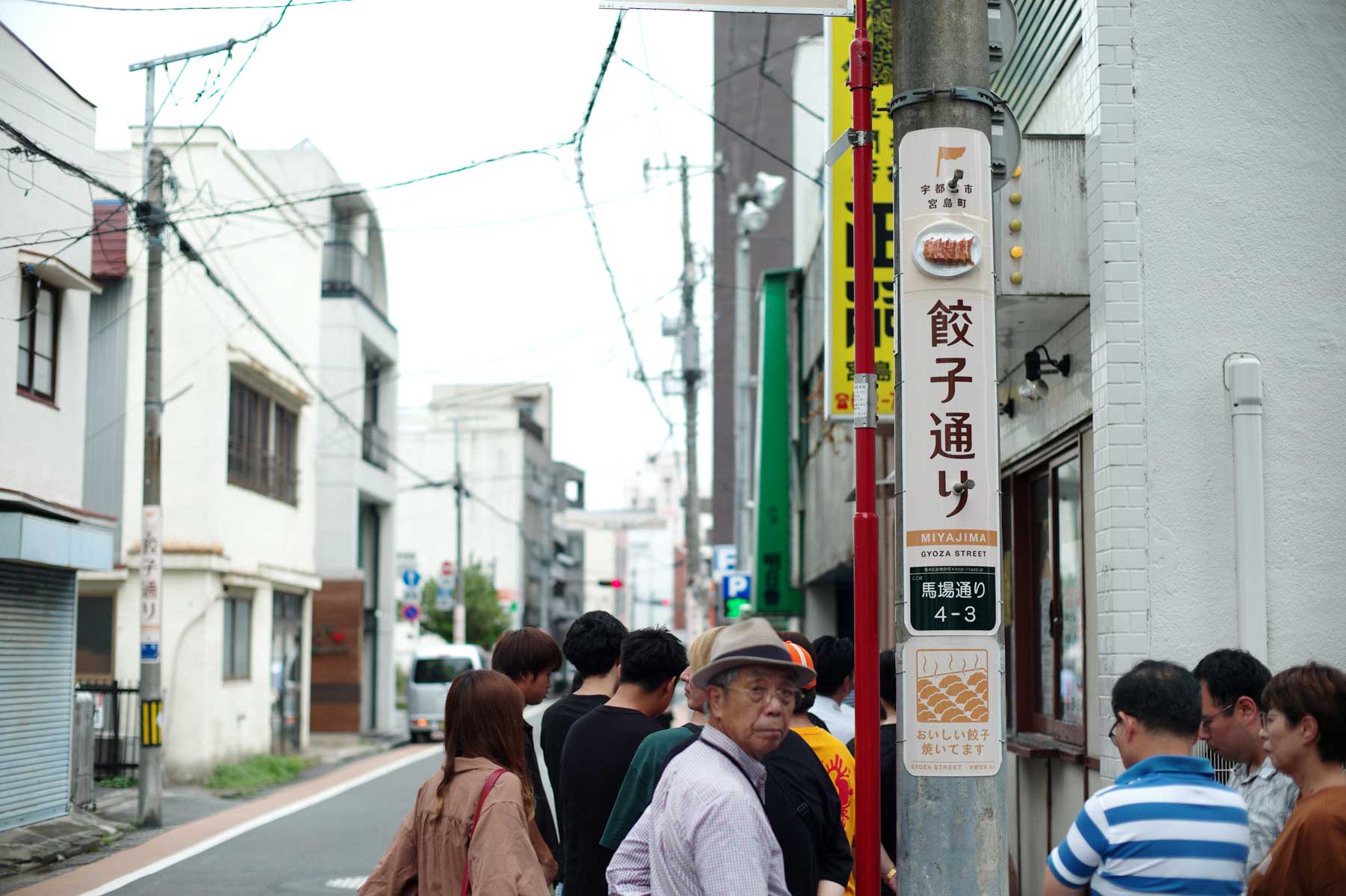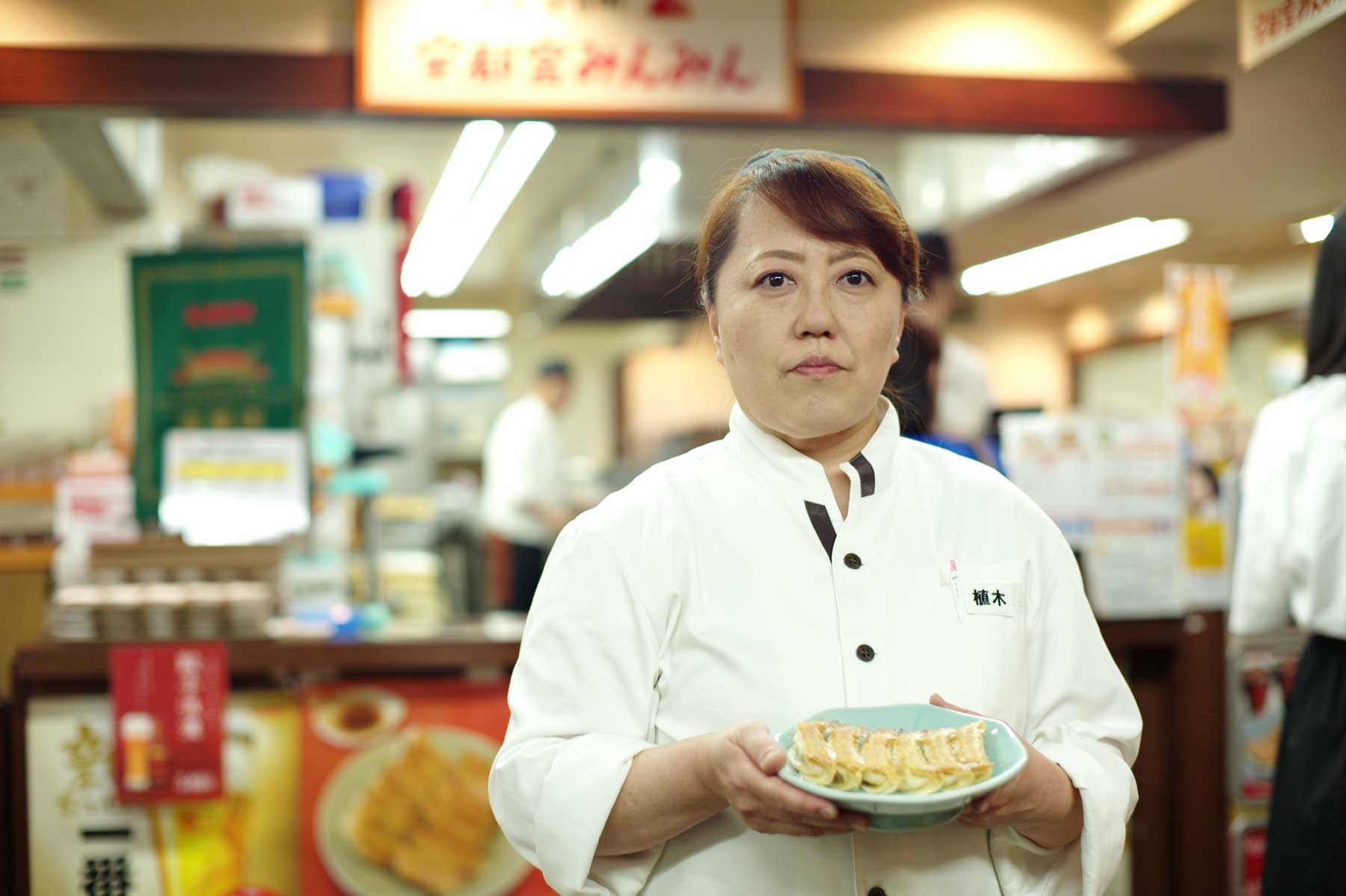LIFE
Food for the soul
Utsunomiya builds a brand around gyōza
Customers enjoy a plate of gyōza at Goku in Utsunomiya, Tochigi Prefecture. RYUSEI TAKAHASHI
Traditional gyōza makers and eateries in Utsunomiya try to keep the dumplings rolling
ALEX K.T. MARTIN
Staff writer
Albert Kuwano Bakonyvari beckons me inside his factory’s steam chamber, where hundreds of plump, white, crescent-shaped gyōza dumplings are neatly lined on stacks of trays fitted in steel racks, waiting to be sent to the freezer.
“Want to try one? I bet you haven’t eaten gyōza at this stage of production,” says the tall Hungarian-American with a goatee.
As I bite into the chewy dough, the warm juice from the ground meat and finely chopped cabbage, chives and leeks spill into my mouth as the scent of garlic hits. Unlike some of the gyōza I’ve had in Tokyo eateries, it’s surprisingly flavorful even without dabbing it in the typical soy sauce, vinegar and chili oil (rāyu) combination, a characteristic I later learn is part of what defines the gyōza made in Utsunomiya, Tochigi Prefecture, where some restaurants advise against the overuse of condiments to avoid killing the flavor of the dumplings.
“We’ve put a lot of time and energy into the dough and I think the texture of our gyōza is unique — it’s firm but it’s delightful to eat at the same time, it doesn’t fall apart but still has a softness,” Kuwano, 54, says.
“For the filling of the gyōza, we use domestic ingredients. The meat, leeks and chives are from Tochigi Prefecture. We use garlic from Aomori Prefecture and cabbage from the Kanto area. We try to keep the flavor relatively simple so the taste of the vegetables can shine through.”
This is the heart of gyōza country, at the gyōza capital of Japan that boasts the highest annual household expenditure on the finger-sized dumplings.
A successful branding campaign led by the city and local gyōza restaurants and makers, combined with word-of-mouth recommendations and media exposure, has made Utsunomiya synonymous with the comfort food. It’s a studied example of machiokoshi (town promotion), so successful, perhaps, that protecting the brand has become an occasional source of contention.
Supersize it
AQ Foods, founded by Hisashi and Ayako Kuwano in 1965 as Eikyu Shokuhin, has been running one of the city’s largest wholesale gyōza businesses, with its products being distributed to department stores and supermarkets across the nation. While the couple is now in semi-retirement, the business was handed down to their son-in-law, Albert, who arrived in Japan in 1991 and married the Kuwanos’ only daughter.
AQ now produces more than a dozen varieties of gyōza and manjū dumplings, with its flagship product being a hand-made jumbo gyōza that weighs 50 grams — more than double the size of a regular gyōza.
“You can’t make quality gyōza of that size using machines. Perhaps 35 grams is the limit,” says Koichi Chiba, the manager of one of AQs factories in Utsunomiya, a land-locked city with a population of around 520,000. In an age of automation, Chiba says AQ is a rarity in that it still produces hand-made gyōza alongside the machine-made variety.
A former itamae chef and a relative of Ayako Kuwano, Chiba and his brother joined AQ around two decades ago. The two apprenticed under the founding couple, with Chiba specializing in the art of making a balanced, flavorful filling that has just the right amount of salt, while his brother oversees the production of gyōza wrappers from scratch.
“For the jumbo gyōza, we have people wrapping them individually and packing them in containers to be shipped,” he says. “Gyōza this size requires real people folding the pleats to seal them. It’s not a skill that can be learned overnight,” he says, typically taking three months of training before the technique is mastered.
“Gyōza is made all over Japan, but the ones made in Utsunomiya are the best and I strive to improve our product every day so I can say ours is No. 1.”
Steamed gyōza sit in trays at AQ Foods in Utsunomiya. RYUSEI TAKAHASHI
The path from China
Gyōza traces its roots to China’s jiaozi dumplings, which are thought to have originated during the Tang Dynasty (618-907), according to Hideaki Otsuka, a Tsukuba University researcher and expert on Chinese culture.
“Dried jiaozi (mummified jiaozi, so to speak) had been excavated from the ruins of Dunhuang. Scholars were surprised to learn that a food so similar to today’s jiaozi, with the typical features of the folded dumpling with pleats, a semicircular shape and pointed edges, was eaten in the Tang Dynasty (618-907),” he said in a lecture he delivered at a food culture seminar hosted by soy sauce manufacturer Kikkoman Corp.’s Tokyo headquarters.
Otsuka says an Edo Period (1603-1868) cookbook introduced three cooking methods for gyōza — deep-frying, pan-frying and steaming — but at the time it was still seen as a Chinese dish and was not a common food.
Chinese cuisine, including jiaozi, began to be served in the Chinatowns of Yokohama, Kobe and other cities during the Meiji Era (1868-1912), but gyōza’s status wasn’t elevated to that of “fast food of choice” until after World War II, when the repatriation of many Japanese from mainland China who were used to eating jiaozi sparked a gyōza boom. But whereas boiled jiaozi is common in China, its birthplace, pan-fried gyōza became the norm in Japan.
The first gyōza restaurant in Utsunomiya is believed to have opened near Utsunomiya Station in 1952, followed by the predecessor to famed gyōza chain Minmin. Other legendary gyōza houses that still serve to this day followed, including Masashi and Koran.
It’s unclear why gyōza shops concentrated in Utsunomiya, although it may have to do with how the city produces many of the dish’s essential ingredients of gyōza, including pork, flour, cabbage and chives. In any case, Utsunomiya residents embraced the dumplings — since 1987, when the then-Management and Coordination Agency began including foodstuff in its annual survey of consumer habits, the city has been repeatedly ranked as the nation’s top gyōza consumer despite the fact that the results excluded gyōza eaten in restaurants. The survey is based on average annual expenditure per household on ready-made gyōza bought and taken home from supermarkets and gyōza restaurants. That means if the figure included gyōza consumed at the numerous gyōza restaurants dotting the city, the number will likely be substantially higher.
“An Utsunomiya city official saw the stats and came up with a plan to promote gyōza as a tourist attraction,” says Hoshimi Kawazu, a spokeswoman for the Utsunomiya Gyoza Association, an organization formed in 1993 with 38 gyōza restaurants. The group became a cooperative association in 2001, and now boasts more than 90 gyōza eateries and manufacturers as members.
Until gyōza became Utsunomiya’s buzzword, the primary tourist draw was the Oya stone mine, Kawazu says, but the quarry that once supplied the Oya stone used for numerous structures in Japan collapsed in 1989, and the city needed an alternative attraction.
In 1993, a TV Tokyo variety show ran a series of programs on Utsunomiya’s love affair with gyōza. Coupled with the launch of an annual gyōza festival and the erection of the Venus of Gyōza statue in 1994, Utsunomiya and its culinary pride were soon pushed into the national spotlight.
Utsunomiya’s decades-long battle with rival Hamamatsu, Shizuoka Prefecture, over the title of No. 1 gyōza-consuming city has also become an annual media event. Hamamatsu beat Utsunomiya in 2018, with households spending an average ¥3,501 annually on gyōza, compared to ¥3,241 in Utsunomiya.
“Until I moved to Utsunomiya 10 years ago, I wasn’t aware how much gyōza is a part of people’s lives,” Kawazu says. “I also think what distinguishes us from other regional revitalization projects is how we work hand in hand with the city office.”
Battle of the brands
As the association’s influence grew, however, it also began implementing stronger measures to protect its brand. The Utsunomiya Gyōza Association was trademarked in 2001, followed by Utsunomiya gyōza being trademarked in 2002. These actions were aimed at clamping down on low-quality gyōza calling themselves Utsunomiya gyōza despite being produced and sold in other prefectures, Kawazu says.
Legal action ensued over the usage of the brand name, and association members were asked to follow strict orders when utilizing the trademarked brand.
In 2017, the operator of Utsunomiya gyōza chain Umaiya — which isn’t a member — reached a settlement with the association after being sued for using Utsunomiya gyōza in its logo. Umaiya offered to take down the word “ganso,” or original, from its product logo and apply for membership.
Then in May, Kuwano’s AQ Foods was removed from the gyōza association, despite being one of the oldest gyōza manufacturers in the city.
“We were asked to join the association to promote Utsunomiya gyōza and make it a thing,” Kuwano says. “We had already been selling it all over the country as Utsunomiya gyōza, and the founder of the association knew that and was eager for us to join since he wanted to use our connections.”
For a long time, the partnership was fruitful, Kuwano says, as Utsunomiya cemented its status as the gyōza mecca, drawing hordes of hungry tourists.
“Unfortunately, all good things like that end up having people with different priorities, and eventually the association started to control the name of Utsunomiya and a lot of our salespeople who used to sell our products as Utsunomiya gyōza were not allowed to do that anymore. The association started to say the name should only be used in Utsunomiya and not around the country, whereas our business is promoting it all across the country.”
“We just had very different paths that we ultimately took, so yeah, we’re not part of the association anymore.”
Without discussing specific issues, Kawazu of the gyōza association says these rules are aimed at controlling quality and to prevent outside makers from using the brand to lure customers.
“Utsunomiya gyōza is such a broad term that it makes it difficult to trace who the producer is when issues surface if it’s used indiscriminately.”
Hisashi and Ayako Kuwano opened AQ Foods in 1965. The producer has since become one of the city’s largest wholesale gyōza businesses. RYUSEI TAKAHASHI
Food for the soul
Dumplings are universal, as seen in their many variations, including the South Asian samosa and momo, and European pierogi and ravioli, says Izumi Kitta, a voice actress and gyōza specialist who also serves as a special ambassador for Utsunomiya gyōza.
“So, in a sense, it was only natural for it to acquire comfort food status in Japan,” she says, adding that she believes Utsunomiya’s public relations campaign helped raise its national prominence.
Kitta, who is currently studying in the United Kingdom, says there were times she would eat gyōza three times a day back in Japan. “I think I was eating around 400 meals of gyōza in 365 days,” she says. Now that she lives in England, she goes out hunting for restaurants serving gyōza and hosts gyōza parties with friends. “It made me want to spread the gospel of gyōza across the world,” she says.
Gyōza has come a long way from its humble beginnings to become firmly embedded in Japan’s culinary psyche. For Hisashi and Ayako Kuwano, their encounter with gyōza was life-changing.
Hisashi, 82, met Ayako, 84, when he was employed as a chef at a Japanese restaurant in Ishinomaki, Miyagi Prefecture. The two soon fell in love and ran off together to Tokyo, where Hisashi hopped around eateries. They ran a food stall, and at one point even cruised around the capital selling fish on a bicycle, but decided to settle down in Tochigi Prefecture, where Hisashi hails from, when their daughter was born.
The couple opened a restaurant in Utsunomiya in 1963 that served popular standard fare such as ramen and chāhan fried rice. One of the regulars was a factory manager for Utsunomiya-based ice cream maker Futaba Foods Co. who suggested the restaurant serve frozen gyōza dumplings Futaba was making to compensate for the fall in ice cream sales during the winter season.
“However, Futaba would halt the production of frozen gyōza once spring came, so we decided to make our own to satisfy our customers’ needs,” Ayako says. The couple’s gyōza was a hit, and they eventually began selling them to other restaurants, and later established a factory.
It wasn’t all smooth sailing, however, and at one point the business was on the verge of collapsing when the price of cabbage soared.
“We fell from the mountaintop to the bottom of the canyon,” Ayako says. “My husband suggested we get a divorce so I won’t have to be burdened by debt, but I couldn’t imagine my family being separated. In the end, we somehow managed to crawl back up.”
The business persevered, and the number of employees grew. Albert, a California native, married the Kuwanos’ daughter in 1997 and later took over the gyōza business.
“I think my father-in-law stumbled upon the perfect product because gyōza has every major food group — you get your carbs, protein, vegetables and it happens to taste very good,” Albert says. It’s very satisfying but not expensive, so it kind of hits every point.”
In 2012, Kuwano launched a craft beer importing business called AQ Bevolution, and opened the Titans Craft Beer Taproom & Bottle Shop in Tokyo’s Otsuka neighborhood to showcase the beer the company imports and, guess what? AQ Foods’ gyōza.
“We have our gyōza and beer at one location,” Kuwano says. “And, as you may know, gyōza and beer go well together.”
The laid-back American may be an unlikely heir to a Japanese family-run gyōza business, but Ayako and Hisashi appreciate his efforts to keep the company going despite the occasional ups and downs.
Asked whether he had any reservations having a foreign national marry their only daughter, Hisashi shakes his head.
“Really? I’ve heard you didn’t want her to marry a gangster or a foreigner,” Albert quips.
“Hmm, perhaps,” Hisashi says with a grin, his eyes wandering as if to recall a distant memory. However, he doesn’t forget to add, “We’re grateful to have you.”

